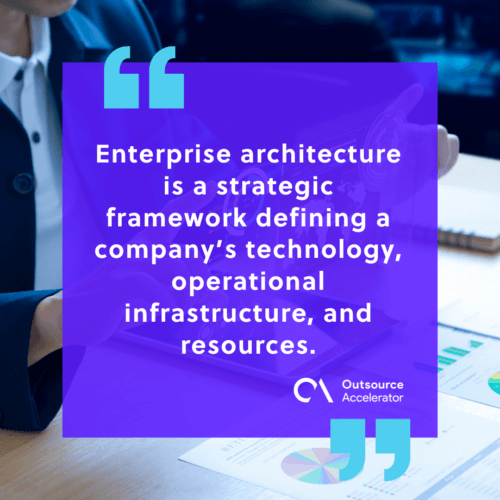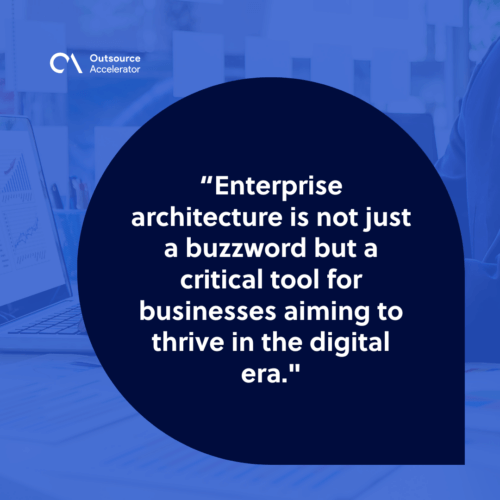The basics of enterprise architecture explained

Organizations constantly strive to improve efficiency, streamline processes, and stay ahead of the competition. To achieve these goals, having a solid implementation of enterprise architecture is critical.
In this comprehensive guide, we will dive into the basics of enterprise architecture, exploring its fundamental concepts and role as the key to success for businesses of all sizes.
What is enterprise architecture?
Enterprise architecture is a strategic framework defining a company’s technology, operational infrastructure, and resources. It provides a holistic view of the organization by capturing its structure, processes, systems, and technologies.
Enterprise architecture serves as a blueprint that guides the design, implementation, and management of an organization’s IT landscape.

Why is enterprise architecture important?
Successfully implementing enterprise architecture brings numerous benefits to organizations. Here are some key reasons why enterprise architecture is crucial for businesses:
- Alignment. Enterprise architecture ensures that the organization’s business goals and objectives are aligned with its IT infrastructure. Defining the relationships between various components helps optimize resources and improve efficiency.
- Flexibility. Enterprise architecture provides a flexible framework that enables businesses to respond swiftly to emerging trends and opportunities.
- Risk management. Companies can identify potential cyber security risks and vulnerabilities with robust enterprise architecture. By proactively addressing these risks, businesses can safeguard their operations and protect sensitive data.
- Cost optimization. Through careful analysis and optimization of IT resources, enterprise architecture helps organizations minimize costs while maximizing their investment value.
- Collaboration: Enterprise architecture promotes collaboration among different business units and stakeholders. It provides a common language and framework that enables effective communication and understanding across departments.
4 key components of enterprise architecture
A solid enterprise architecture comprises several key components working in harmony.
Understanding these components is essential to building a cohesive and effective architecture.
The main components of enterprise architecture include:
1. Business architecture
Business architecture defines the organization’s strategic objectives, business processes, and organizational structure.
It outlines how the organization interacts internally and with external stakeholders.
2. Data architecture
Data is the lifeblood of any organization, and data architecture ensures its proper management and utilization. It includes defining data models, governance policies, and integration strategies.

3. Application architecture
Application architecture deals with designing and integrating software applications that support the organization’s business functions.
It includes selecting appropriate technologies to form a technology stack, defining application interfaces, and ensuring interoperability.
4. Technology architecture
Technology architecture encompasses the hardware, software, and network infrastructure that supports the organization’s operations.
It covers aspects such as standards, protocols, and security measures to ensure a robust and scalable IT ecosystem.
Examples of enterprise architecture
To further understand how enterprise architecture applies in the real world, let’s explore some industry examples:
Manufacturing
Enterprise architecture plays a pivotal role in streamlining operations in the manufacturing industry. This aspect integrates production systems, supply chain management, and customer relationship management.
Enterprise architecture benefits manufacturing companies in terms of optimized production, reduced lead times, and enhanced customer satisfaction.
Financial services
In the financial services sector, enterprise architecture ensures compliance, data security, and seamless user experiences.
It enables the integration of core banking systems, payment gateways, customer relationship management platforms, and risk management tools. This integration provides a holistic view of the organization and its operations.
Healthcare
Enterprise architecture is even widely utilized in healthcare institutions. It provides a framework for integrating electronic health records, medical imaging, patient management, and billing systems.
This integration ensures efficient communication and collaboration among healthcare providers, improving patient outcomes.
Retail
For retail businesses, enterprise architecture helps optimize the supply chain, inventory management, and online sales platforms.
Businesses can provide their customers with a seamless omnichannel shopping experience by integrating various systems such as:
- Point-of-sale
- Customer relationship management
- E-commerce platforms
Real estate
In the real estate industry, enterprise architecture supports integrating property management systems, customer relationship management platforms, and financial systems.
This integration improves efficiency, enables better client service, and streamlines business processes.
Enterprise architecture as the key to success
Enterprise architecture provides organizations with a strategic framework to align their business goals with their technology infrastructure.
By embracing enterprise architecture, businesses can achieve better alignment between business and IT, optimize costs, manage risks, and foster collaboration.
Enterprise architecture is not just a buzzword but a critical tool for businesses aiming to thrive in the digital era. It acts as a roadmap for organizations, guiding them toward successful digital transformation and helping them outrank their competitors.

Investing in enterprise architecture is a wise choice for organizations of all sizes.
By understanding its basics, recognizing its importance, and implementing it strategically, businesses can unlock their full potential and thrive in the digital era.
Regardless of business size, consider investing in enterprise architecture to unlock the full potential of your organization.







 Independent
Independent




